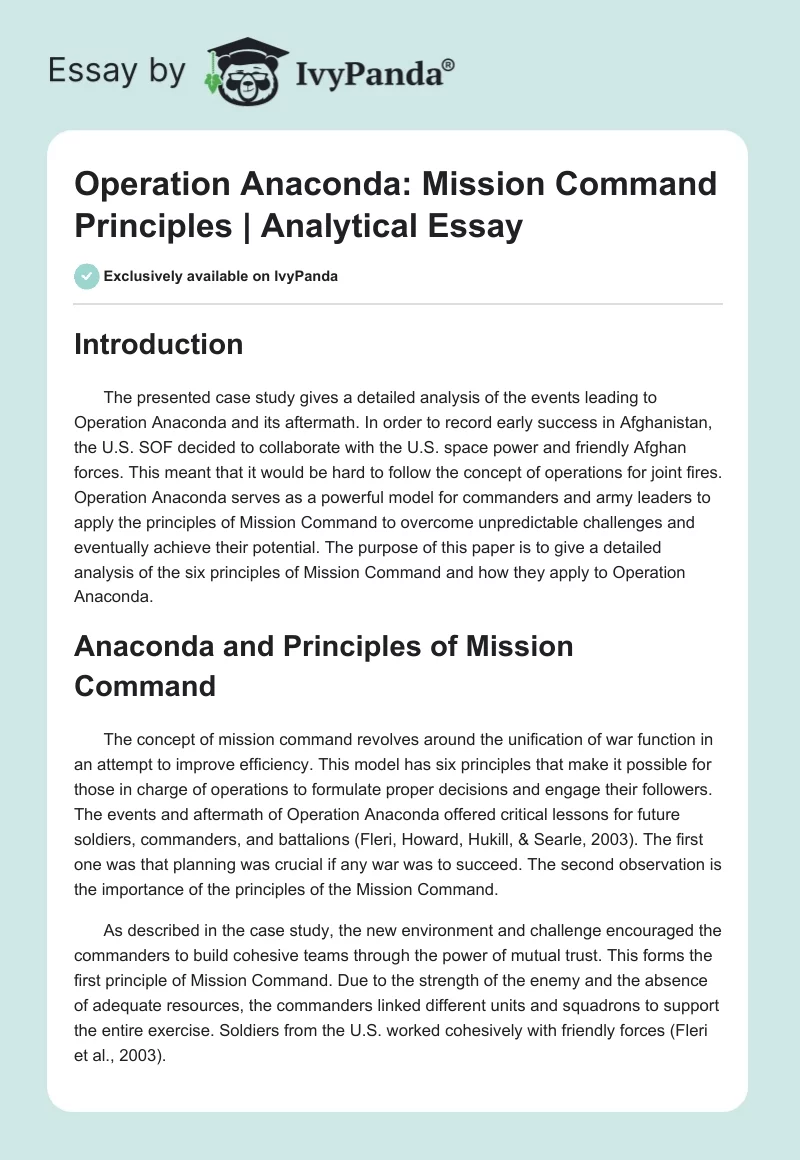Introduction
The presented case study gives a detailed analysis of the events leading to Operation Anaconda and its aftermath. In order to record early success in Afghanistan, the U.S. SOF decided to collaborate with the U.S. space power and friendly Afghan forces. This meant that it would be hard to follow the concept of operations for joint fires. Operation Anaconda serves as a powerful model for commanders and army leaders to apply the principles of Mission Command to overcome unpredictable challenges and eventually achieve their potential. The purpose of this paper is to give a detailed analysis of the six principles of Mission Command and how they apply to Operation Anaconda.
Anaconda and Principles of Mission Command
The concept of mission command revolves around the unification of war function in an attempt to improve efficiency. This model has six principles that make it possible for those in charge of operations to formulate proper decisions and engage their followers. The events and aftermath of Operation Anaconda offered critical lessons for future soldiers, commanders, and battalions (Fleri, Howard, Hukill, & Searle, 2003). The first one was that planning was crucial if any war was to succeed. The second observation is the importance of the principles of the Mission Command.
As described in the case study, the new environment and challenge encouraged the commanders to build cohesive teams through the power of mutual trust. This forms the first principle of Mission Command. Due to the strength of the enemy and the absence of adequate resources, the commanders linked different units and squadrons to support the entire exercise. Soldiers from the U.S. worked cohesively with friendly forces (Fleri et al., 2003).
The outcome was a form of mutual trust that continued to sustain the entire exercise. Within the two weeks of this operation, American soldiers and friendly forces came under heavy attack from their rivals (Perry & Kassing, 2015). Fortunately, they survived since they were brave, and their commanders provided the relevant instructions and guidelines continuously. They established cohesive teams eventually delivered the intended results.
The second principle revolves around the commander’s ability to create a common understanding. After the establishment of cohesive teams in Afghanistan, the commanders presented the outlined goals and objectives that would guide the entire process. The lash-up between TACS and SOF resulted in doctrinal weaknesses and battlespace issues. The establishment of an Air Control Element (ACE) led to the development of a robust organization characterized by personnel from different forces (Fleri et al., 2003). The absence of resources and support systems worsened the situation for the U.S. soldiers. However, the commanders ensured that their followers had a common understanding of the situation and the anticipated goals.
The third principle is the ability to provide a clear intent. Throughout this operation, commanders informed all soldiers about the targeted objectives, the perceived challenges, and the predicted enemy size. This knowledge became the best guideline for pursuing the intended objectives (Fleri et al., 2003). Although the implemented level of intelligence was unable to predict the exact size of the enemy and location, the leaders were keen to provide the best information regarding the intent of the entire mission (Fleri et al., 2003). Since the established solid plans and the adopted advanced surveillance systems did not prevent the surprises the enemy presented, the commanders remained clear and continued to provide evidence-based guidelines throughout the process.
The fourth principle is the ability to exercise disciplined initiative. Since the fighters were from different forces, their leaders encouraged them to remain disciplined and focus on the wider goal or objective. They communicated in accordance with the established command chain in order to resolve every emerging issue quickly (Perry & Kassing, 2015). The concept of discipline continued to guide the entire process. The followers obeyed orders, engaged one another, and worked as teams to overcome the existing challenges.
The fifth principle is the ability to use mission orders. Throughout the exercise, those in charge embraced this attribute to ensure all soldiers and fighters responded efficiently to the pronounced guidelines. The ultimate objective was to defeat the enemy without killing civilians. Operation Enduring Freedom in the Middle East triggered new organizational structures after the operations of different tactical forces became visible to the enemy (Richemond-Barak, 2018). This meant that the time had come for the CAOC and CENTCOM to bypass established command systems.
The final one is the ability to accept prudent risk. The commanders followed this principle to decentralize decision-making processes and empower their subordinates (Richemond-Barak, 2018). They generated opportunities and engaged in intelligence gathering throughout the period. Unfortunately, the case does not explain whether the commanders used the concepts of risk analysis and assessment to mitigate potential negative outcomes. This was the reason why they were unable to locate different civilians.
Conclusion
The above discussion has identified Operation Anaconda as a military action that presented different weaknesses without necessarily failing. This was possible since the commanders applied the principles of Mission Command to deliver positive results. However, they failed to identify potential risks and implement powerful mechanisms to address them. Future commanders should, therefore, study this case carefully and develop superior philosophies that can eventually improve performance.
References
Fleri, E. M., Howard, C. E., Hukill, J., & Searle, T. R. (2003). Operation Anaconda case study. Maxwell, AL: College of Aerospace Doctrine.
Perry, W. L., & Kassing, D. (2015). Toppling the Taliban: Air-ground operations in Afghanistan, October 2001-June 2002. Santa Monica, CA: RAND Corporation.
Richemond-Barak, D. (2018). Underground warfare. New York, NY: Oxford University Press.


